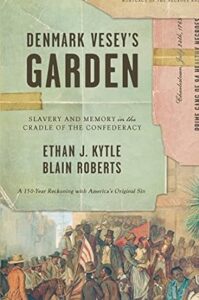 Summary: An exploration of how historical memory has changed over time using Charleston, SC, as an example.
Summary: An exploration of how historical memory has changed over time using Charleston, SC, as an example.
I have been fascinated with the concept of historical memory. I was introduced to the concept earlier, but the first book I read that concentrated on historical memory is Race and Reunion: The Civil War in American Memory by David Blight. Since then, I have read several books that take on more aspects of historical memory, like Myth America and A More Beautiful and Terrible History: The Uses and Misuses of Civil Rights History by Jeanne Theoharis.
Denmark Vesey’s Garden is similar to Race and Reunion. Still, instead of an expansive look at a shorter time (a national look at the 50 years after the Civil War in Race and Reunion), Denmark Vesey’s Garden was a narrow geography but went from the Antebellum era until the 2010s. This means they complement one another well. What I wanted more from Race and Reunion was a more extended period, and Denmark Vesey’s Garden was able to show not just the intentional misremembering of history but also the movement back toward a more accurate memory.
There was a good section on music, especially the spirituals and their role in historical memory. By this account, it was primarily white preservationists who maintained the Gullah spirituals. There was an intentional preservation aspect to these (segregated) white choirs who performed spirituals. Still, their preservation work also assumed white supremacy because they did not believe that Black musicians could preserve the spirituals. These white groups ignored the Black, often church-based, musicians preserving the music in parallel. In addition to the paternalistic attitudes that believed that white preservation was needed, there was a reluctance for many Black singers to perform for white audiences because of the ways that white audiences expected stereotyped performances. This book cites Howard Thurman’s autobiography, discussing how Thurman, as a student, did not like singing for white audiences because of the cultural prejudice about what white audiences understood spirituals to be about. It is not that Thurman did not like the spirituals; he has a book about their importance; it is that he did not like how white audiences coded their prejudice on the music and performance.
I was surprised how early tourism impacted the historical memory in Charleston. Tourism arose as a significant part of the Charleston economy within a few years of the end of the Civil War, and by the mid-1930s, an estimated 300,000 tourists a year were visiting. These tourists came from the north and south and had different expectations of what they would see. It is frankly shocking to me that through the mid-20th century, there was a denial of slave trading as an actual thing that happened in Charleston, even though we know today that Charleston was the largest entry point of enslaved people in the US. In some ways, the reality of how tourism works is part of the development of historical memory. The US has always wanted its tourism to be educational, but a particular type of educational. Tourists mostly wanted to see big houses and stereotypical plantations influenced by media like Gone With the Wind. Understanding how slavery actually worked was not high on the list of the type of education most tourists were looking for. It was not until the 1990s that National Parks and museums or other tours started even to offer a more balanced historical approach to slavery. How the Word Is Passed: A Reckoning with the History of Slavery Across America by Clint Smith is very good at exploring how slavery is handled at tourist sites today, but Denmark Vesey’s Garden gives some historical background.
We must grapple with historical memory because our current memory is distorted. I live in Georgia; in 2021, a law about how schools can handle controversial topics was passed. As part of the law, it says that the country cannot be presented as being systemically racist. There are some exceptions for presenting history, but what I think is important for topics like the Dred Scott ruling and the Civil War and issues of historical memory is that the country was systemically racist. I am curious to know how it is possible to meet the requirements of the GA law and accurately teach Dred Scott, an 8th-grade social studies standard. Nikki Haley’s comments about the cause of the Civil War were influenced by Lost Cause mythology. And while South Carolina stopped flying the Confederate Battle Flag over the capitol while she was governor, perceptions of what people are willing to hear will influence what politicians are willing to say.
If we do not know how history was repressed and how it has been rediscovered again, we will not understand how false memory influences current reality. I know some reasons why, but it is common that reports on the historical influences of slavery or racism on institutions tend to stop before confronting current history. Southern Baptist Seminary’s 2018 report on its history stopped in the 1960s. Wheaton College’s report stopped at about 2000. One of the encouraging facts of this book is that it went up until about 2015, just before the book was published. That recent history and a clear-eyed look at how recently false memories were taught as fact must be understood and addressed.
Denmark Vesey’s Garden: Slavery and Memory in the Cradle of the Confederacy by Ethan J. Kytle and Blain Roberts Purchase Links: Paperback, Kindle Edition, Audible.com Audiobook